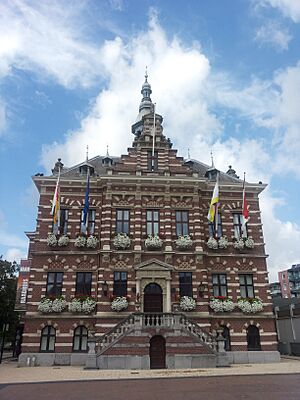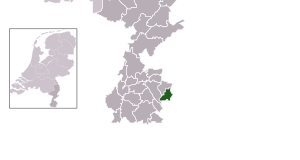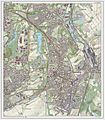Kerkrade facts for kids
Quick facts for kids
Kerkrade
Kirchroa |
|||
|---|---|---|---|

Kerkrade city hall
|
|||
|
|||

Location in Limburg
|
|||
| Country | Netherlands | ||
| Province | Limburg | ||
| Government | |||
| • Body | Municipal council | ||
| Area | |||
| • Total | 22.13 km2 (8.54 sq mi) | ||
| • Land | 21.90 km2 (8.46 sq mi) | ||
| • Water | 0.23 km2 (0.09 sq mi) | ||
| Elevation | 155 m (509 ft) | ||
| Population
(May 2014)
|
|||
| • Total | 46,627 | ||
| • Density | 2,129/km2 (5,510/sq mi) | ||
| Demonym(s) | Kerkradenaar | ||
| Time zone | UTC+1 (CET) | ||
| • Summer (DST) | UTC+2 (CEST) | ||
| Postcode |
6460–6471
|
||
| Area code | 045 | ||
Kerkrade is a town and a municipality in the southeast of Limburg. Limburg is the southernmost province of the Netherlands. Kerkrade is part of a larger urban area called Parkstad Limburg.
Kerkrade is special because it's half of a divided city. It used to be part of the German town of Herzogenrath. In 1815, after the Congress of Vienna, a new border was drawn. This border separated the towns, making Kerkrade the Dutch side and Herzogenrath the German side. The international border runs right through the eastern part of the city.
Together, Kerkrade and Herzogenrath have almost 100,000 people. Nearly 47,000 of these people live in Kerkrade.
Contents
A Look at Kerkrade's Past
The story of Kerkrade is closely connected to its neighbor, Herzogenrath, which is just across the German border. Herzogenrath started as a small settlement called Rode in the 11th century. It was located near the river Worm.
In 1104, Augustinian monks built an abbey called Kloosterrade. This abbey was located west of the settlement. The area later became known as 's-Hertogenrode or 's-Hertogenrade. This name means "the Duke's Rode" in Dutch. It was named this way after the duchy of Brabant took control of the region. In French, it was called Rolduc.
Like many places in the Southern Netherlands, Kerkrade changed rulers many times. It was controlled by Spain from 1661. Then it was under Austrian rule between 1713 and 1785. From 1795 to 1813, it was part of France. In 1815, the Kingdom of the Netherlands was formed. The border was drawn through Herzogenrath, and the western part became Kerkrade.
Coal Mining and Growth
In the 18th century, the monks at Rolduc Abbey started digging for coal on a small scale. More modern coal mining began in 1860. This caused Kerkrade to grow a lot. Many miners from Southern Europe moved to the area to work.
Around 1900, the Willem Sophia mine opened. This made the town grow even faster. Old villages like Chèvremont became part of Kerkrade. However, in the decades after 1960, all the coal mines in Limburg closed down.
One of the oldest buildings in Kerkrade is Erenstein. This is a castle that dates back to the 14th century.
The Unique Border Street
A very interesting part of the border between the Netherlands and Germany runs right down the middle of a street. This street is called Nieuwstraat in Dutch and Neustraße in German.
During World War I and World War II, the Germans heavily guarded this border. After World War II, it was marked by a low wall, about 30 centimeters high. This wall ran along the street. Cars had to use official crossing points, but people could easily step over the wall. There were signs to show where the border was.
In 1995, the wall was completely removed. This happened because of the new Schengen Area agreement. This agreement allows people to travel freely between many European countries. Now, Nieuwstraat/Neustraße is a single road. The space where the wall used to be is now filled with trees and bicycle lanes. The border is not marked, and you cross it without even noticing, for example, when going around a roundabout.
Working Together Across the Border
The two towns, Kerkrade and Herzogenrath, now share some public services. They also work together to attract businesses. They call themselves a binational "City of Eurode."
They even share a special office building called Eurode. This building is built so that the border goes right through the middle of its main lobby. One part of the building is in Kerkrade, and the other part is in Herzogenrath.
Neighborhoods and Areas
Kerkrade has many different neighborhoods and housing areas. Some of these include:
- Bleijerheide
- Chevremont
- Eygelshoven
- Gracht (Kerkrade)
- Haanrade
- Holz
- Hopel
- Kaalheide
- Mucherveld
- Nulland
- Ondernemend gedrag
- Rolduc
- Rolduckerveld
- Spekholzerheide
- Terwinselen
Music and Events
Every four years, Kerkrade hosts the World Music Contest. This is a big competition for amateur, professional, and military bands. It's a very exciting event for music lovers. Also, the Drum Corps Europe championships have been held here for several years.
Getting Around Kerkrade
Kerkrade has four railway stations, making it easy to travel by train:
- Kerkrade Centrum
- Chevremont
- Eygelshoven
- Eygelshoven Markt
Another station, Kerkrade West (or Spekholzerheide), closed for public use in 1988. Since 1992, it has been used by a museum railway company called ZLSM.
Kerkrade's Unique Reservoir
A dam was built in the Anstel, which is a small stream west of Kerkrade. This created a reservoir, which is like a large artificial lake. It covers about 20 hectares (about 50 acres). This reservoir and the area around it are full of interesting plants and animals. It is the only reservoir of its kind in the Netherlands.
Sports in Kerkrade
Kerkrade is home to some exciting sports:
- Roda JC is a professional soccer team.
- Powerarea is a place where you can go racing on a kart circuit.
Famous People from Kerkrade
Many notable people have come from Kerkrade:
- Gabriël Grupello (1644–1730) was a famous sculptor who made many beautiful statues.
- Heintje Simons (born 1955) is a well-known Dutch singer and actor.
- Janine Kitzen (born 1978) is a talented soprano singer who performs in opera and musical theater.
- Emma Kok (born 2008) is a young singer who won The Voice Kids in 2021.
Sports Stars from Kerkrade
Kerkrade has also produced many great athletes:
- Wiel Coerver (1924-2011) was a famous footballer and coach.
- Willy Brokamp (born 1946) was a football player with a long career.
- Mark Flekken (born 1993) is a Dutch footballer.
- Joshua Brenet (born 1994) is another Dutch footballer.
- Jannah Sonnenschein (born 1996) is a swimmer who competed in the 2016 Summer Olympics.
Images for kids
See also
 In Spanish: Kerkrade para niños
In Spanish: Kerkrade para niños










